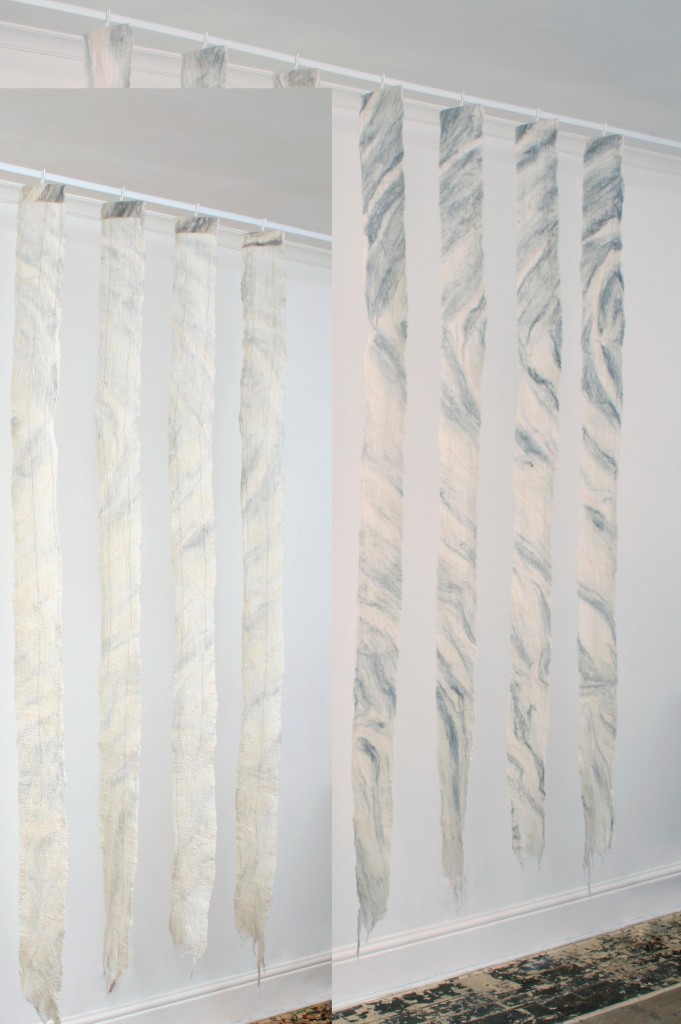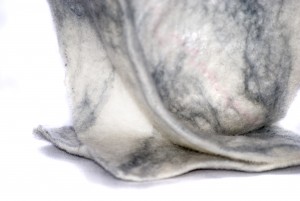I would like to commend http://www.textileartist.org/dee-thomas/ – apart from being a great read it has beautiful images. Textile Artists have a great subscription service and in particular many interviews with textile artists across the world. The only problem will be keeping up with the publications…
_________
For my first news blog I have selected Obscure Barrier partly because of the variety of materials used, but also the design, and how it was presented in my 2010 solo at Gallery at St.Martin’s, Lincoln.
Materials
- Mulberry silk squares deconstructed
- Mulberry silk viscose yarn
- Banana yarn – lustrous, fine slub yarn
- Carded cashmere and silk – superfine fibres
- Carded merino and silk – superfine fibres
- Ramie white tops (Chinese nettle)
- Merino (white, light and dark grey)
- Metallic threads and yarns (including Angelina – ice sparkle and silver hologram)
- Viscose – a unique form of wood cellulose acetate (pink)
Design, Process and Evaluation
A scale drawing of the selected contour design had been transferred to a sheet of bubble wrap, which allowed me to make sure that the two sections of the design matched up. Also when viewed, the contour lines can be clearly seen by the viewer from both sides of the felt.
Laying out the mulberry silk was particularly time consuming because of its flimsy nature, and keeping thicker lines of silk in place was more difficult than expected (eventually made easier by adding a little glue stick to the bubble wrap). The ultra-fine second layer of merino and silk blend acted as the key, which encouraged the felting process. The third layer included lines of banana yarn interspersed with mulberry silk viscose twist yarn to provide structure and contrasting texture and shade. On top of this, another fine layer of merino and silk blend, provided the fibres necessary to produce a robust felt. This final layer was combined with other fibres to create the design with pink, silver and grey contour lines. Developed from previous studies, this also reflects life and nature entwined with its twists and turns, the rhythm of life and movement in fibre. The idea emerged that damaged land, damaged society and damaged human beings should be represented by division of the felt into thin panels with rough edges and hanging by a thread. The use of cobweb technique created a fine semi-transparent felt where the detail is evident, particularly as the light shines through the fibres. The intention was to highlight both the fragility and strength of human beings.
Felting was undertaken in stages due to the large scale of the curtain felt, and by necessity this was broken down into two main parts which were then worked in three sections during the layout and part felted. The two main sections were further felted using the rolling process, but only for a limited time, as longer lengths of felt can distort if not turned. The process involved felting down the length to reduce shrinkage across the width. The final felting was by hand, a long process but one that provides much more control. Each section has been cut leaving eight narrow panels to work with. The final felting by hand concentrated on keeping width rather than length. Length was adjusted at the top as fixings were added, the challenge was keeping the contour pattern in place as the length was adjusted. Issues of health and safety required consideration because visitors walked through the work, so care was needed to ensure that feet could not become entangled (ceiling to floor height 2370mm).

To display the felt my research indicated that the most useful and flexible fixing would be a drape curtain rail. This was bent into shape and fixed directly to the ceiling. The number of felt sections finally used was seven. Curtain hooks were fixed in place on the rail and visitors had no option but to touch the felt to enter the gallery. The view into the gallery was not obscured so that people did not feel inhibited about entering.
A graduation of tone was clearly visible in the shading between contour lines. The intended fine semi-transparent felt includes a variety of texture, as planned. The silk contour lines and fine layers of Mulberry silk were worth the effort involved, giving the work lustre and strength. The white side of the felt has a luminous quality enhanced by light. Additional variation and interest was achieved by the use of the Mulberry twist viscose yarn, banana yarn and lustre from the thicker edges of the Mulberry silk squares. Whilst the banana yarn has kinked and blended with the wool, the viscose twist yarn has remained straight. The occasional glimpse of sparkle on the grey side of the felt is a result of blending Angelina fibres, Ramie and pink viscose, adding a reflective quality to the matt of the wool fibres, to make a soft lustrous felt with a fluid feel, which is lightweight and durable.
The result was a semi-transparent flimsy looking hanging, a barrier which had to be negotiated to access the gallery space. Brushing against the skin created sensory feedback and allowed the felt to be closely examined. The intention was to highlight the fragility and strength of the human being, to enable the viewer to consider how life can be for those who confront barriers on a daily basis.
